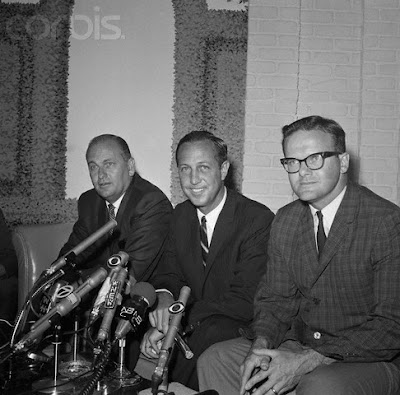http://www.dallasnews.com/sports/super-bowl/
Published 01 February 2011
 Tex Schramm (President of the Dallas Cowboys and the National Football League), NFL Commissioner Pete Rozelle, and Lamar Hunt (Founder of the American Football League and President of the Kansas City Chiefs) as they all talk to newsmen. They met in New York on June 8, 1966 to announce that the NFL and AFL will merge under one commissioner by 1970. The merger ended a costly rivalry between the two leagues.
Tex Schramm (President of the Dallas Cowboys and the National Football League), NFL Commissioner Pete Rozelle, and Lamar Hunt (Founder of the American Football League and President of the Kansas City Chiefs) as they all talk to newsmen. They met in New York on June 8, 1966 to announce that the NFL and AFL will merge under one commissioner by 1970. The merger ended a costly rivalry between the two leagues.(Bettmann/CORBIS)
Between parties and practices this week, at least one Steelers rep should make a pilgrimage to Dallas’ Frontiers of Flight Museum, there to kneel at the feet of the Texas Ranger.
No, not Nolan Ryan. Hang with me a minute. More Texas icons to come.
If not for a fateful 1966 meeting in the lobby at Love Field , where the “One Riot, One Ranger” statue proudly stood watch until last fall, the Steelers might not be at the Super Bowl now.
Or anywhere else, for that matter.
One of the world’s winningest organizations the last 40 years, the Steelers were something less than that the previous 40. Sports’ greatest turnaround can be traced to six men and a stadium:
Dan Rooney , son of Pittsburgh’s patriarch, Art Rooney Sr., gave the Steelers new direction; Chuck Noll , their great head coach, “gave us class,” as the old man once put it; Mean Joe Greene provided the Steelers a defensive anchor; Terry Bradshaw, a franchise quarterback; Three Rivers, a decent place to play.
And Lamar Hunt and Tex Schramm kept the Steelers from going bust.
But before we explore Dallas’ contribution, a bit of history first:
In nearly 40 years of football until 1972, the Steelers had piled up a total of eight winning seasons. They were awful in nearly every way possible: on the field, in the front office and at the pay window. They couldn’t draft straight. When they did, they screwed that up, too.
They took two Hall of Fame quarterbacks in the ’50s and ended up cutting Johnny Unitas and trading Len Dawson . And they passed on Jim Brown to pick Dawson.
 And it got worse. In ’59, ’60 and ’63, the Steelers didn’t pick until the eighth round. In ’62, they had a first, then sat out the draft until the eighth round. In ’65, the only pick they had in the first nine rounds was a second.
And it got worse. In ’59, ’60 and ’63, the Steelers didn’t pick until the eighth round. In ’62, they had a first, then sat out the draft until the eighth round. In ’65, the only pick they had in the first nine rounds was a second.The Steelers largely blame this era of omission on Buddy Parker, who’d come over from the Lions in ’57. Buddy didn’t care for rookies. The story goes that Dan Rooney consistently bumped heads with him over the bias.
But the Steelers’ poor draft history wasn’t all Parker’s fault. They didn’t do much scouting. Only one of their first-rounders from 1960 to ’68 ever started for them, and Parker was gone by ’65.
The Steelers’ problem was systemic: They didn’t have any money to spend.
Bidding wars with the AFL hurt many, not the least Pittsburgh. The Steelers became poster boys for a new trend, which was to draft according to signability, not talent. And that’s how they came to pick a running back out of West Virginia named Dick Leftridge in ’66.
Schramm’s evaluation of Leftridge in Jeff Miller’s book, Going Long: a third-round value, at best.
Draft strategies like Pittsburgh’s convinced Schramm that he had to do something fast for the good of the NFL, which is where Lamar Hunt comes in.
On April 6, 1966, the brains behind the Cowboys and the AFL’s founder rendezvoused at the Ranger statue. After brief negotiations in Schramm’s Oldsmobile, they agreed to an outline of a merger.
Besides eventually ending the bidding wars, the merger gave the Steelers an added bonus: Moving to the AFC, along with the Browns and Colts, netted Pittsburgh a $3 million relocation fee, paid out over five years.
“That’s the first time,” Art Sr. said in The Chief, a biography by Jim O’Brien, “we had real money to work with.”
Under the guidance of Noll and Dan Rooney, Pittsburgh put the windfall to use. In ’69, the Steelers made North Texas State’s Greene their best first-round pick in a half-century. The next year, when a host of teams, including the Cowboys, clamored after the first pick of the draft, the Steelers surprised one and all.
“If everybody wants this guy so bad,” Art Sr. told Gil Brandt, “he must be pretty good. I think we’ll take him.”
So Terry Bradshaw became a Steeler instead of a Cowboy, one of 10 first-round hits in a row for the Steelers. Except for the 40 years in the wilderness part, this, friends, is how dynasties are built. And to think two visionary Dallas football leaders helped make it possible. Oh, for one more.


No comments:
Post a Comment